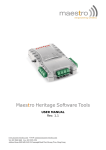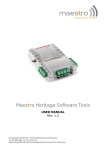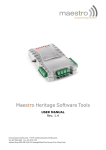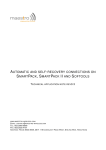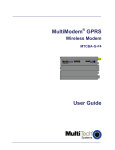Download MASTERO 20 USER GUIDE
Transcript
Maestro Smart Pack
User Manual
GSM GPRS Modem
900 / 1800
Eco Lite Ext
Confidential, the whole present document is the sole property of Maestro Wireless Solutions Ltd.
Revision history
Rev.
0.94b
0.94d
Date
22 Apr 2007
01 Jan 2008
Details
First release for new Maestro 100 series
Add Remote program update feature
Originated by
Wallace Lee
Wallace Lee
This manual is written without any warranty. Maestro Wireless Solutions Ltd. reserves the
right to modify or improve the product and its accessories which can also be withdrawn without
prior notice.
Besides, our company stresses the fact that the performance of the product as well as
accessories depends not only on the proper conditions of use, but also on the environment
around the places of use.
Maestro Wireless Solutions Ltd. assumes no liability for damage incurred directly or indirectly
from errors, omissions or discrepancies between the modem and the manual.
Confidential, the whole present document is the sole property of Maestro Wireless Solutions Ltd.
Table of contents
1.
INTRODUCTION.................................................................................................................................................................................................... 3
2.
INSTALLATION ..................................................................................................................................................................................................... 3
2.1.
2.1.1.
2.2.
3.
2.2.2.
Downloading the file .................................................................................................................................................... 4
GPRS AND TCP/UDP PARAMETERS SETUP..................................................................................................................................................... 5
3.2.
GPRS NETWORK PARAMETERS .......................................................................................................................................... 5
AT+IPGPRS command ................................................................................................................................................. 5
ACTIVATING GPRS CONNECTION ....................................................................................................................................... 6
3.2.1.
AT+CGATT command.................................................................................................................................................. 6
3.2.2.
AT+IPCONNECT command ........................................................................................................................................ 6
3.3.
TCP/UDP PARAMETERS SETUP .......................................................................................................................................... 7
3.3.1.
AT+IPTCP command.................................................................................................................................................... 7
3.3.2.
AT+IPUDP command ................................................................................................................................................... 9
3.3.3.
AT+IPBUFF command ............................................................................................................................................... 10
3.4.
3.4.1.
EXTRA TCP/UDP PARAMETERS SETUP ............................................................................................................................ 11
AT+IPOPT command.................................................................................................................................................. 11
AUTOMATIC AND SELF-RECOVERY TCP/UDP CONNECTION ...................................................................................................................... 12
4.1.
FLOW DIAGRAM OF AUTO TCP/UDP CONNECTION FUNCTION .......................................................................................... 13
4.2.
AT COMMANDS FOR AUTO TCP/UDP CONNECTION ......................................................................................................... 14
4.2.1.
AT+AUTOTCP command .......................................................................................................................................... 14
4.2.2.
AT+AUTOUDP command.......................................................................................................................................... 15
4.3.
4.3.1.
AT COMMANDS FOR TUNING AUTO TCP/UDP CONNECTION............................................................................................. 16
AT+AUFCM command .............................................................................................................................................. 16
AT COMMAND DRIVEN TCP/UDP CONNECTION ............................................................................................................................................ 17
5.1.
6.
INSTALLING THE SMART PACK ............................................................................................................................................ 3
Erasing the IP connectivity feature (Except Maestro 100 ECO).................................................................................. 3
3.1.1.
5.
Identifying Maestro 100 by AT command .................................................................................................................... 3
2.2.1.
3.1.
4.
IDENTIFYING YOUR MAESTRO 100 ..................................................................................................................................... 3
AT COMMANDS FOR AUTO TCP/UDP CONNECTION ......................................................................................................... 17
5.1.1.
AT+DLEMODE command ......................................................................................................................................... 17
5.1.2.
AT+OTCP command .................................................................................................................................................. 18
5.1.3.
AT+OUDP command.................................................................................................................................................. 18
REMOTE AT COMMAND BY SMS...................................................................................................................................................................... 20
6.1.
DESCRIPTION OF THE OPERATION ..................................................................................................................................... 20
6.2.
AT COMMAND FOR CONFIGURING AT COMMAND .............................................................................................................. 21
6.2.1.
6.3.
AT+SMSAT command................................................................................................................................................ 21
LIMITATION AND CAUTION TO BE TAKEN WHEN USING REMOTE AT COMMAND ................................................................. 21
Confidential, the whole present document is the sole property of Maestro Wireless Solution Ltd.
1
7.
I/O TRIGGERED AT COMMAND......................................................................................................................................................................... 23
7.1.
DESCRIPTION OF THE OPERATION ..................................................................................................................................... 23
7.2.
AT COMMAND FOR CONFIGURING I/O TRIGGERED AT COMMAND ..................................................................................... 24
7.2.1.
7.3.
8.
AT+CSRN command .................................................................................................................................................. 26
8.1.2.
AT+CSNW command ................................................................................................................................................. 26
8.1.3.
AT+CSNR command .................................................................................................................................................. 27
8.1.4.
AT+CSND command.................................................................................................................................................. 28
MODEM STATUS CHECK AND MONITORING.................................................................................................................................................. 29
AT+TMODE command .............................................................................................................................................. 29
9.1.2.
Operation of Modem Status Check and Monitoring ................................................................................................... 30
REMOTE PROGRAM UPDATE........................................................................................................................................................................... 31
13.
AT COMMAND FOR REMOTE PROGRAM UPDATE ................................................................................................................ 31
10.1.1.
AT+IPFTP .............................................................................................................................................................. 31
10.1.2.
AT+FTPDOTA....................................................................................................................................................... 32
10.1.3.
AT+ADINSTALL .................................................................................................................................................. 33
10.2.
12.
AT COMMAND FOR MODEM STATUS CHECK AND MONITORING ........................................................................................ 29
9.1.1.
10.1.
11.
AT COMMAND FOR CONFIGURING CALL SCREENING ......................................................................................................... 26
8.1.1.
9.1.
10.
NOTES AND CAUTIONS TO BE TAKEN WHEN USING I/O TRIGGERED AT COMMAND ............................................................ 25
CALL SCREENING ............................................................................................................................................................................................. 26
8.1.
9.
AT+IOAT command.................................................................................................................................................... 24
NOTES AND CAUTIONS TO BE TAKEN ON USING REMOTE PROGRAM UPDATE ...................................................................... 34
KNOWN ISSUES ................................................................................................................................................................................................. 35
11.1.
MUTUALLY EXCLUSIVE TCP/UDP FUNCTIONS. ................................................................................................................ 35
11.2.
SENDING MAESTRO SMART PACK AT COMMANDS OVER SMS.......................................................................................... 35
QUESTIONS AND ANSWERS ............................................................................................................................................................................ 36
12.1.
INSTALLATION .................................................................................................................................................................. 36
12.2.
AUTOTCP/UDP ............................................................................................................................................................... 36
12.3.
AT COMMAND DRIVEN TCP/UDP CONNECTION ............................................................................................................... 36
12.4.
REMOTE AT COMMAND BY SMS ...................................................................................................................................... 37
12.5.
I/O TRIGGERED AT COMMAND .......................................................................................................................................... 37
EXAMPLES OF MSP SETUP AND OPERATION ............................................................................................................................................... 38
13.1.
TO SETUP AN AUTOMATIC TCP CONNECTION .................................................................................................................... 38
13.2.
TO MAKE A AT COMMAND DRIVEN TCP CONNECTION ...................................................................................................... 38
13.3.
PERFORM REMOTE PROGRAM UPDATE BY SENDING COMMAND OVER SMS...................................................................... 39
Confidential, the whole present document is the sole property of Maestro Wireless Solution Ltd.
2
1. INTRODUCTION
Maestro Smart Pack (MSP) package is a software solution for Maestro 100 series modems. New functions added to
increase application range of various industrial and automated applications:
-
Automatic and self-recovery TCP/UDP socket connection (*note 1)
-
AT command driven TCP/UDP socket connection (*note 1)
-
Remote AT command (AT command through SMS)
-
I/O triggered AT command execution
-
Call screening (reject call made by unauthorized phone number)
-
Modem status check and monitoring
-
Remote program updating (Maestro 100 and Maestro 100 EXT only)
Users can configure and use the above features by AT commands.
Note 1: Not available for Maestro 100 ECO model
2. INSTALLATION
2.1. Identifying your Maestro 100
First check the Maestro 100 firmware before installation.
2.1.1. Identifying Maestro 100 by AT command
Start HyperTerminal, choose correct baud rate to communicate with the modem
Then enter the following and see the response according to the following table:
Model
Maestro 100/LITE/EXT
Maestro 100 ECO
Command
ATI3
ATi3
Expected response (first 8 characters )
657_09gg or 657c_09gg
657_09gm or 657c_09gg
If you get the same response then this modem is ready for installation.
2.2. Installing the Smart Pack
2.2.1. Erasing the IP connectivity feature (Except Maestro 100 ECO)
You may need to erase the IP connectivity feature before downloading the Smart Pack. Again, on HyperTerminal enter
the following commands step by steps:
Command entered
AT+WOPEN=0
AT+WOPEN=3
AT+WOPEN=4
Expected response
(modem may reset)
OK
(modem may reset)
Confidential, the whole present document is the sole property of Maestro Wireless Solution Ltd.
3
2.2.2. Downloading the file
a. Check the HyperTerminal is configured with setting “8 data bits, no parity, 1 stop bit, and hardware flow control
(CTS/RTS)
b. It is suggested to set the baud he RS232 link is changed to 115200 bps. You can first start HyperTerminal session with
9600 bps. The on the screen type command AT+IPR = 115200 and then press “Enter”. Then change the HyperTerminal
speed to 115200bps.
c. On the screen type the command AT+WDWL and then press “Enter”. The modem should answer +WDWL: 0, and then
a series of strange characters appear or the cursor is just moving forward slowly. (the modem is sending the first
characters of the Xmodem protocol).
d. Then on HyperTerminal you choose “Transfer” –“Send File”
e. When you see the dialog box, on the “Filename” you choose file according to the modem:
Maestro 100 : M100_VAF_096d_OAT316_32.dwl
Then on “Protocol” choose “Xmodem”, then press “OK”
Then the downloading process will start:
f. After finishing downloading enter command AT+CFUN=1 to restart modem
g. After restarting enter command AT+WOPEN=1 to start the MSP program (modem will restart).
h. Enter MSP version command AT+VAFV to verify :
Command
AT+VAFV
Expected response
M100_VAF_094d_OAT316_32 Nov 11 200718:01:42
OK
Now the Maestro Smart Pack installation has been done. You can follow other chapters to use the features.
Confidential, the whole present document is the sole property of Maestro Wireless Solution Ltd.
4
3. GPRS AND TCP/UDP PARAMETERS SETUP
Note: This chapter does not applicable to Maestro 100 ECO
The Automatic and AT command driven TCP/UDP connection (described in Chapter 4 and 5) requires GPRS connection
and TCP / UDP parameters setup. This chapter will describe those required setups.
3.1. GPRS Network Parameters
User need to enter the following parameters for GPRS connection:
-
Access point name (APN)
-
User name
-
Password
They are to be entered by using AT+IPGPRS command. Contact your network operator for these parameters.
3.1.1. AT+IPGPRS command
Description:
This command is used to setup GPRS network parameters for the TCP/UDP connection feature.
Command Syntax
AT+IPGPRS=<Cid>,<APN>,<UN>,<PW>
Response Syntax
+IPGPRS: <Cid>,<APN>,<UN>,<PW>
Command
AT+ IPGPRS?
AT+ IPGPRS=1,
AT+ IPGPRS =1,”INTERNET”
AT+ IPGPRS=?
Possible responses:
+IPGPRS: 1,"INTERNET","" ,””
OK
Note: show current settings
OK
Note: set Cid value to 1
OK
Note: set the PDP value to 1 and APN to “INTERNET”
+IPGPRS: (1-4),(100),(50),(50)
OK
Note: possible values
Defined Values :
<Cid>
PDP context identifier.
Note: to use with MSP TCP/UDP connection feature this value must be set to 1.
<APN>
Access point name of the GPRS network. Max 100 characters.
<UN>
User name to access the GPRS service. Max 50 characters.
<PW>
Password used to access the GPRS service. Max 50 characters.
Confidential, the whole present document is the sole property of Maestro Wireless Solution Ltd.
5
3.2. Activating GPRS Connection
For using AT command driven TCP/UDP connection (described in Chapter 5), you need to first activate the MSP GPRS
connection. There are two AT commands:
-
AT+CGATT
-
AT+IPCONNECT
3.2.1. AT+CGATT command
This standard AT command is to make the modem to attach to or detach GPRS network. For details please read AT
command document.
Command Syntax
AT+CGATT=<state>
Response Syntax
+CGATT: <state>
Command
AT+ CGATT?
AT+ CGATT=1
AT+ CGATT =0
Possible responses:
+CGATT: 0
OK
Note: display current status
OK
Note:GPRS attach success
OK
Note:GPRS detach success
Defined Values:
<state>
1:
attach GPRS
0:
detach GPRS.
3.2.2. AT+IPCONNECT command
This MSP AT commands is to make the modem to activate or deactivate GPRS connection . Once IPCONNECT is
success you can perform TCP/UDP connection as described on other chapters. Please read note below on using this
command.
Command Syntax
AT+IPCONNECT = <Bearer>,<Connect>
Response Syntax
+IPCONNECT: <Bearer>,<Connect>
Command
AT+ IPCONNECT=?
AT+ IPCONNECT?
AT+IPCONNECT=1,1
Possible responses:
+IPCONNECT: (0-1) , (0-1)
OK
Note: display possible values
+IPCONNECT: 1,0
OK
Note: display current status
OK
OK
OK
Note: Activate GPRS connection success
Confidential, the whole present document is the sole property of Maestro Wireless Solution Ltd.
6
AT+IPCONNECT=1,1
AT+ IPCONNECT =1,0
+CME ERROR: 3
Note: Activate GPRS connection fail
OK
Note: Deactivate GPRS connection success
Defined Values:
<Bearer>
0:
using GSM Bearer ( Note: do NOT use this for MSP )
1:
using GPRS Bearer.
<Connect>
0:
to stop connection
1:
to start connection.
Note: Before you making GPRS connection by this command make sure you have finished the following first:
1. Entered APN settings by AT+IPGPRS command Chapter 3.1.1)
2. Attached to GPRS network by AT+CGATT command (Chapter 3.2.1)
It is suggested after modem power up wait about 20 seconds before making GPRS connection.
3.3. TCP/UDP Parameters Setup
For using automatic or AT command driven TCP/UDP connection (described in Chapter 4 and 5), you need to first enter
the target TCP/UDP peer parameters. There are
-
AT+IPTCP
-
AT+IPUDP
-
AT+IPBUFF
-
3.3.1. AT+IPTCP command
This command specifies the TCP socket parameters and mode that to be used by automatic or AT command driven TCP
connection (described in Chapter 4 and 5).
Command Syntax
AT+IPTCP=<port>,<mode>,<server>,<TCPTxDelay>
Response Syntax
+ IPTCP: <port>,<mode>,<server>,<TCPTxDelay>
Command
AT+ IPTCP?
AT+ IPTCP =23
AT+ IPTCP =23,”C”,202.144.111.222”,0
Possible responses:
+IPTCP: 0,"S","",0
OK
Note : show current settings
OK
Note: set the TCP port to 23
OK
Note: to set the modem to connect TCP socket Client (caller)
mode
to target :address 202.144.111.222 and port 23
Confidential, the whole present document is the sole property of Maestro Wireless Solution Ltd.
7
AT+ IPTCP =23,”S”,255.255.255.255”,0
AT+ IPTCP =?
OK
to set the modem to wait for TCP socket connection request
(Server (listening) mode)
any calling IP address allowed, port 23
+IPTCP: (0-65535),("C","S"),(120),(0-1)
OK
Note : possible argument
Defined Values:
<port>
The port number to be used for the TCP socket connection. Default value is 0. Valid range is 0 to 65535.
<mode>
Mode of TCP operation. Default value is “S”.
“S”
Server (Listening) mode. This configures Maestro 100 to open a listening TCP connection on the specified <port> .
The TCP connection will be active upon getting socket connection request from the allowed remote TCP peer (see
<address>)
“C”
Client (caller) mode. This configures Maestro 100 to request opening a TCP connection to the server with the
specified <address> and <port> .
Note: This parameter is used by Auto TCP connection (see Chapter 4) only.
<address>
The address of the TCP server (or host). Default value is empty. Legal values could be 32-bit in dotted-decimal notation
(i.e. xxx.xxx.xxx.xxx) or alphanumeric ASCII test string up to 120 characters (only if DNS is available on the GPRS
network)
Note: In “Server” (Listening) mode the modem will only accept TCP connection request for the caller with address
specified in the <address> field. Yet if the it is set to “255.255.255.255” the modem will accept request from ANY
address.
<TCPTxDelay>
This parameter determines if there is time delay introduced before sending a TCP frame that has not been entirely filled
with user data. If it is set to 0 initiates the sending of a TCP frame as soon as possible after the reception of a single
character value from the host. If it is set to 1 initiate a delay will be introduced before the sending of a TCP frame
The default value is 0.
Confidential, the whole present document is the sole property of Maestro Wireless Solution Ltd.
8
3.3.2. AT+IPUDP command
This command specifies the UDP socket parameters and mode that to be used by automatic or AT command driven UDP
connection (described in Chapter 4 and 5)..
Command Syntax
AT+IPUDP=<port>,<mode>,<server>,<UDPTxDelay>
Response Syntax
+ IPUDP: <port>,<mode>,<server>,<UDPTxDelay>
Command
AT+ IPUDP?
AT+ IPUDP =23
AT+ IPUDP =23,”C”,202.144.111.222”,0
AT+ IPUDP =23,”S”,255.255.255.255”,0
AT+ IPUDP=?
Possible responses:
+IPUDP: 0,"S","",0
OK
Note : show current settings
OK
Note: set the UDP port to 23
OK
Note: to set the modem to connect UDP socket Client (caller)
mode
to target :address 202.144.111.222 and port 23
OK
to set the modem to wait for UDP socket connection request
(Server (listening) mode)
any calling IP address allowed, port 23
+IPUDP: (0-65535),("C","S"),(120),(0-1)
OK
Note : possible argument
Defined Values:
<port>
The port number to be used for the UDP socket connection. Default value is 0. Valid range is 0 to 65535.
<mode>
Mode of UDP operation. Default value is “S”.
“S”
Server (Listening) mode. This configures Maestro 100 to open a listening UDP connection on the specified <port> .
The UDP connection will be active upon getting socket connection request from the allowed remote UDP peer (see
<address>)
“C”
Client (caller) mode. This configures Maestro 100 to request opening a UDP connection to the server with the
specified <address> and <port> .
Note: This parameter is used by Auto UDP connection (see Chapter 4) only.
<address>
The address of the UDP server (or host). Default value is empty. Legal values could be 32-bit in dotted-decimal notation
(i.e. xxx.xxx.xxx.xxx) or alphanumeric ASCII test string up to 120 characters (only if DNS is available on the GPRS
network)
Note: In “Server” (Listening) mode the modem will only accept UDP connection request for the caller with address
specified in the <address> field. Yet if it is set to “255.255.255.255” the modem will accept request from ANY address.
Confidential, the whole present document is the sole property of Maestro Wireless Solution Ltd.
9
<UDPTxDelay>
This parameter determines if there is time delay introduced before sending a UDP frame that has not been entirely filled
with user data. If it is set to 0 initiates the sending of a UDP frame as soon as possible after the reception of a single
character value from the host. If it is set to 1 initiates a delay will be introduced before the sending of a UDP frame
The default value is 0.
3.3.3. AT+IPBUFF command
This command specifies the number of bytes of payload data from remote peer buffered inside the modem when
automatic or AT command driven TCP / UDP connection is made.
-
If the quantity of buffered data reach this value, the whole buffered data will be sent out to the serial port.
-
If the data from remote is large enough at one time, only multiple of this value data will be sent out to the serial port
remainder will be kept inside buffer.
Example: AT+IPBUFF=5
1234567890A
18 bytes of data sent
from TCP or UDP
socket to modem
BCDEFGH
FGH
15 bytes (multiple of
5) data sent out to
serial port, remaining
data buffered inside
1234567890A
Command Syntax
AT+IPBUFF = <buff>
Response Syntax
+IPBUFF: <buff>
Command
AT+ IPBUFF=?
AT+ IPBUFF?
AT+IPBUFF = 5
Possible responses:
+IPBUFF: 0-100
OK
Note: display possible values
+IP BUFF: 0
OK
Note: display current status
OK
Note: Set IPBUFF value to 5
Confidential, the whole present document is the sole property of Maestro Wireless Solution Ltd.
10
Defined Values:
<buff>
The number of bytes of data to be buffered. Default value is 0 (i.e. no buffering). Valid range is 0 to 100.
Note: If the TCP or UDP socket connection is broken, buffered data will be lost.
3.4. Extra TCP/UDP Parameters Setup
User can set additional parameters of TCP/UDP connection, including “keep alive” packet, maximum packet size and
TTL.
3.4.1. AT+IPOPT command
This command specifies the extra TCP/UDP socket parameters.
Command Syntax
AT+IPOPT=<CMDType>,<parameter>
Response Syntax
+ IPOPT: <CMDType>,<parameter>
Command
AT+ IPOPT?
AT+ IPOPT =1,100
AT+IPOPT=2,512
AT+ IPOPT=3,128
AT+ IPOPT=?
Possible responses:
+IPOPT: 1, 0
+IPOPT: 2, 536
+IPOPT: 3, 64
OK
Note: display current settings
OK
Note: enable the keep alive packet feature (every 100 seconds)
OK
Note: set the size of maximum packet that to be sent to 512 bytes
OK
Note:set TTL to 128
+IPOPT: (1-3),(0-65535)
OK
Note : possible argument
Defined Values:
<CMDType>
1
setup “keep alive” packet feature:
when <parameter> is 0, the feature is disabled
when <parameter> is n where n is from 1 to 1048575, then upon a TCP socket connected, an empty “keep alive”
packet will be sent out from the modem every n seconds to avoid socket being closed because of idle timeout.
2
specifies the maximum size of the outgoing packet to <parameter>. The size can be set from 1 to 65535(0xFFFF)
default value is 65535.
3
specifies the TTL value of the socket connection to <parameter>. The value can be set from 1 to 255.
default value is 128.
Confidential, the whole present document is the sole property of Maestro Wireless Solution Ltd.
11
4. AUTOMATIC AND SELF-RECOVERY TCP/UDP
CONNECTION
Note: This chapter does not applicable to Maestro 100 ECO
The Auto TCP/UDP connection feature is defined for accessing serial devices over the Internet. Maestro 100 can be
configured that after power up it will connect to a remote TCP/UDP socket (client mode) or to wait for the TCP/UDP
socket connection request from remote peer (server mode).
If the socket connection is unsuccessful or disconnected it will repeat the connection request and back to waiting stage.
This make remote peer can access serial device connected to Maestro 100.
Direct serial connection
RS-232 cable
serial device
TCP Socket connection via the Internet /GPRS network
Broad band
RS-232 cable
GPRS
Fixed IP:
123.456.789.0
Program monitoring
Auto TCP connection set to connect
Port 23
123.456.789.0 port 23
Confidential, the whole present document is the sole property of Maestro Wireless Solution Ltd.
12
4.1. Flow diagram of Auto TCP/UDP connection function
Modem Power on/
restart
No
Is AutoTCP/UDP
enabled ?
Stop
Yes
W ait for 20 secs
No
Re-attach GPRS
No
GPRS attach OK ?
Yes
Re-activate GPRS
No
GPRS activation OK ?
Yes
TCP/UDP connection
request from allowed
peer?
No
No
Client mode ?
Yes
No
OK to open pre-defined
TCP/UDP socket ?
Dealy 2
seconds
Yes
No
Open TCP/UDP
socket, connect to
serial port
Open TCP/UDP
socket, connect to
serial port
TCP/UDP
disconnected or
closed ?
TCP/UDP
disconnected or
closed ?
Yes
Yes
GPRS attach fail ?
No
Yes
GPRS activation
fail ?
No
No
Yes
GPRS attach fail ?
Yes
No
GPRS activation
fail ?
Yes
No
Confidential, the whole present document is the sole property of Maestro Wireless Solution Ltd.
13
4.2. AT commands for Auto TCP/UDP connection
4.2.1. AT+AUTOTCP command
This command controls the Maestro 100 to start TCP socket connection automatically
Before using AT+AUTOTCP TCP and GPRS settings MUST be setup properly using AT+IPTCP and AT+IPGPRS
command respectively.
Command Syntax
AT+AUTOTCP=<mode>
Response syntax:
+AUTOTCP: <mode>
Command
AT+AUTOTCP=0
AT+AUTOTCP=1
AT+ AUTOTCP?
AT+AUTOTCP=?
Possible responses:
OK
Note : disable AutoTCP
OK
Enable AutoTCP
+AUTOTCP : 1
OK
Note display current status
+AUTOTCP : (0-1)
Note : possible argument
Defined Values:
<mode>
1
enable auto TCP
0
disable auto TCP
Note :
-
Before enabling Auto TCP, it MUST be properly set the GPRS settings by AT+IPGPRS command and TCP settings
by AT+IPTCP command (see Chapter 3)
-
ONLY GPRS PDP context # 1 will be used. So please setup +IPGPRS settings with <cid>=1
-
Once AutoTCP is enabled, it will start the TCP socket connection automatically after 20 seconds.
-
Once the TCP connection is established successfully, the serial port will go to data mode, all data entered to the serial
port will be sent to remote TCP peer. No more AT commands will be accepted then.
-
In TCP connected data mode, the DSR and DCD signals of the serial port will go to high.
-
If the TCP connection is broken the modem will try to reconnect automatically. During re-connection period serial port
will go back to command mode, and DSR/DCD signal back to low.
-
The setting will be saved, and after power off, the AUTOTCP will be restarted with the 20 seconds delay after power
up.
-
To stop auto TCP connection, you need to enter the command AT+AUTOTCP=0 by either 1: within 20 seconds after
power up, or 2: during reconnection (serial port back to command mode), or 3: by SMS (see Chapter , SMS AT
command).
-
Auto TCP connection is exclusive to other TCP/UDP feature. See Chapter 10 (Q&A)
Confidential, the whole present document is the sole property of Maestro Wireless Solution Ltd.
14
4.2.2. AT+AUTOUDP command
This command controls the Maestro 100/100 Lite to start UDPacket connection automatically.
Before using AT+AUTOUDP TCP and GPRS settings MUST be setup properly using AT+IPUDP and AT+IPGPRS
command respectively.
Command Syntax
AT+AUTOUDP=<mode>
Response syntax:
+AUTOUDP: <mode>
Command
AT+AUTOUDP=0
AT+AUTOUDP=1
AT+ AUTOUDP?
AT+AUTOUDP=?
Possible responses:
OK
Note : disable AutoUDP
OK
Note: Enable AutoUDP
+AUTOUDP : 1
OK
Note: display current status
+AUTOUDP : (0-1)
Note : possible argument
Defined Values:
<mode>
1
enable auto UDP
0
disable auto UDP
Note :
-
Before enabling Auto UDP, it MUST be properly set the GPRS settings by AT+IPGPRS command and UDP settings
by AT+IPUDP command
-
ONLY GPRS PDP context # 1 will be used. So please setup +IPGPRS settings with <cid>=1
-
Once AutoUDP is enabled, it will start the UDP socket connection automatically after 20 seconds.
-
Once the UDP connection is established successfully, the serial port will go to data mode, all data entered to the
serial port will be sent to remote UDP peer. No more AT commands will be accepted then.
-
In UDP connected data mode, the DSR and DCD signals of the serial port will go to high.
-
If the UDP connection is broken the modem will try to reconnect automatically. During re-connection period serial port
will go back to command mode, and DSR/DCD signal back to low.
-
The setting will be saved, and after power off, the AUTOUDP will be restarted with the 20 seconds delay after power
up.
-
To stop auto UDP connection, you need to enter the command AT+AUTOUDP=0 by 1: within 20 seconds after
power up, or 2: during reconnection (serial port back to command mode) or 3: by SMS (see Chapter , SMS AT
command).
-
Auto TCP connection is exclusive to other TCP/UDP feature. See Chapter 10 (Q&A)
-
Due to the nature of UDP socket connection, AT+AUTOUDP=0 may not be able to disconnection. in this case you
may send command AT+IPCONNECT=1,0 to disconnect GPRS connection.
Confidential, the whole present document is the sole property of Maestro Wireless Solution Ltd.
15
4.3. AT commands for tuning Auto TCP/UDP connection
4.3.1. AT+AUFCM command
This command controls the buffering time of TDP/UDP data sent to remote peer. Data coming towards UART will be
buffered for a “delay” period before being sent out.
Command Syntax
AT+AUFCM=<delay>
Response syntax:
+AUFCM: <delay>
Command
AT+AUFCM=1
AT+ AUFCM?
AT+AUFCM=?
Possible responses:
OK
Note : set the +AUFCM value to 1
+AUFCM : 2
OK
Note: display current status
+AUFCM : (1-255)
Note : possible argument
Defined Values:
<delay>
Default value: 0
Possible value: 1 to 255
Delay units between sending buffered data to TCP/UDP peer. The actual delay time is calculated by the value of <delay>
times 18.5 ms. So if <delay> is equal to 2 that means data will be sent to remote peer every 39ms (or immediately if
internal buffer is full) Increasing this value can make the data packet size bigger especially when data flow is slow, thus
reducing overhead.
Note :
-
If the value is set too high the maximum data transfer speed may be decreased.
Confidential, the whole present document is the sole property of Maestro Wireless Solution Ltd.
16
5. AT COMMAND DRIVEN TCP/UDP CONNECTION
Note: This chapter does not applicable to Maestro 100 ECO
This feature let user to make a TCP or UDP connection upon the AT+OTCP or AT+OUDP command.
This socket connection feature do support DLE/ETX character coding. See
The AT+OTCP and AT+OUDP operation is similar to AT#OTCP and AT#OUDP function provided original IP Connectivity.
See IP connectivity document.
Make sure you have made the GPRS connection by AT+IPCONNECT command before making socket connection (see
Chapter 11, setup examples).
5.1. AT commands for Auto TCP/UDP connection
5.1.1. AT+DLEMODE command
When performing the AT command driven TCP or UDP socket connection, the attached host has the choice to code or
not the ETX character.
When DLEMODE is set to 0, no specific process is needed on ETX characters. It means that it is not possible for a host
to request a end of connection or to receive a clear indication of end of connection from the TCP/IP stack.
When DLEMODE is set to 1, the ETX character means a request or an indication of end of connection.
As a consequence, ETX characters that belongs to the payload data must be sent by the host on the serial port preceded
by a DLE
character. Similarly ETX characters received by the TCP/IP stack from the Internet are sent to the host through the serial
port preceded by a DLE character
“ETX” is character hex 03, “DLE” character is hex 10 (Dec 16)
Default value is 0.
Command Syntax
AT+DLEMODE=<mode>
Response syntax:
+DLEMODE: <mode>
Command
AT+ DLEMODE =0
AT+ DLEMODE =1
AT+ DLEMODE?
AT+ DLEMODE =?
Possible responses:
OK
Note : disable DLEMODE
OK
Note: Enable DLEMODE
+DLEMODE : 1
OK
Note: display current status
+DELMODE : (0-1)
Note : possible argument
Defined Values:
<mode>
1
enable DLEMODE
0
disable DLEMODE
Confidential, the whole present document is the sole property of Maestro Wireless Solution Ltd.
17
Note :
-
DLEMODE is not available for Automatic TCP/UDP connection.
5.1.2. AT+OTCP command
This command sent by the attached host to open a TCP connection to the TCP server specified by the AT+IPCTP
command. If socket connection is made successfully it will response CONNECT 115200 and the serial port will go to data
mode, all data entered to the serial port will be sent to remote TCP/UDP peer.
If socket connection is unsuccessful or socket is disconnected afterwards the modem will send out NO CARRIER
message and back to command mode.
Command Syntax
AT+OTCP
Response syntax:
CONNECT 115200
Command
AT+ OTCP
Possible responses:
CONNECT 115200
Note : TCP connection made successfully
+CME ERROR 3
Note: fail, either IPCONNECT is not ready or socket service
is used already
NO CARRIER
Note: possibly remote server no response
AT+ OTCP
AT+ OTCP
Note :
-
AT+OTCP connection is exclusive to other TCP feature. See Chapter (Q&A)
-
If TCP connection is unsuccessful or broken after connection the GPRS connection will also be disconnected.
(+IPCONNECT: 1,0). So please enter AT+IPCONNECT=1,1 to reconnect GPRS before entering AT+OTCP.
5.1.3. AT+OUDP command
This command sent by the attached host to open a UDP connection to the UDP server specified by the AT+IPUDP
command. If socket connection is made successfully it will response CONNECT 115200 and the serial port will go to data
mode, all data entered to the serial port will be sent to remote UDP peer.
If socket connection is unsuccessful or socket is disconnected afterwards the modem will send out NO CARRIER
message and back to command mode.
Command Syntax
AT+OTCP
Response syntax:
CONNECT 115200
Command
AT+ OUDP
AT+ OUDP
Possible responses:
CONNECT 115200
Note : UDP connection made successfully
+CME ERROR 3
Note: fail, either IPCONNECT is not ready or socket service
is used already
Confidential, the whole present document is the sole property of Maestro Wireless Solution Ltd.
18
AT+ OUDP
NO CARRIER
Note: possibly remote server no response
Note :
-
AT+OUDP connection is exclusive to other TCP/UDP feature. See Chapter (Q&A)
-
If UDP connection is unsuccessful or broken after connection the GPRS connection will also be disconnected.
(+IPCONNECT: 1,0). So please enter AT+IPCONNECT=1,1 to reconnect GPRS before entering AT+OUDP.
-
Due to the nature of UDP socket connection, sending ETX characters (when DLEMODE is 1)may not be able to
make disconnection.
Confidential, the whole present document is the sole property of Maestro Wireless Solution Ltd.
19
6. REMOTE AT COMMAND BY SMS
This feature is to control the modem to interpret AT command from incoming SMS, executing it, and return the result to
sender by SMS.
The user can enable the modem to receive AT command by incoming SMS. See following about AT+SMSAT command.
6.1. Description of the Operation
Step 1 : send AT command to
modem by SMS
000000AT+CSQ
Step 2 : modem execute and
return response by SMS
+CSQ: 17,0 OK
1. When enabled, the modem will treat the incoming SMS as a source of AT command only if all of the following
conditions (a,b and c) are fulfilled :
a. The content of SMS sent to the modem is using standard 7-bit GSM data decoding scheme,
b. The first 6 characters of the SMS content matches the <key> parameter set by AT+SMSAT command, (default key
is “000000”)
c. The 7th and 8th characters of the SMS content is “AT” (in capital letters)
2. If SMSAT is enabled , the modem will read each incoming SMS, if the conditions mentioned in 1 are matched the
message will be executed, even it is an invalid AT command
3. When using SMSAT feature, only +CNMI:x,1,x,x,x setting could be used (i.e. incoming message will be stored in SIM
card).
4. The maximum length of the AT command is limited by length of SMS, i.e. 160-6 = 154 characters
5. When the SMS AT command is executed , all intermediate and final responses will be buffered recorded, then return to
the sender’s phone number in one single SMS.
6. If response(s) of the AT command is(are) more than 160 characters, only the first 160 characters will be returned.
7. In case the modem cannot get terminal response within 26 seconds, the modem will then abort the command, and
return intermediate responses (if present).
8. If the SMSAT feature is enabled, all incoming SMS, either with valid AT command or not, will be erased. This is to
prevent SIM card memory from fully filled, such the modem will not receive new SMS.
Confidential, the whole present document is the sole property of Maestro Wireless Solution Ltd.
20
6.2. AT command for configuring AT command
6.2.1. AT+SMSAT command
Command Syntax
AT+SMSAT=<mode>(,<key>)
Response syntax:
+SMSAT: <mode>,<key>
Command
AT+SMSAT=0
AT+ SMSAT =1
AT+ SMSAT?
AT+SMSAT=2,123456
AT+ SMSAT =?
Possible responses:
OK
Note : disable remote AT command by SMS
OK
Enable remote AT command by SMS
+SMSAT : 1,000000
OK
Note display current status
OK
Note: set the <key> value
+SMSAT : (0-2),(6)
OK
Note : possible argument
Defined Values:
<mode>
0
disable remote AT command by SMS
1
enable remote AT command by SMS
2
change the value of the <key>
<key>
A 6-digit numeric character key from 000000 to 999999. Only incoming SMS with the first 6 characters matching with this
key will be treated as a valid source of remote AT command.
6.3. Limitation and caution to be taken when using remote AT command
This feature will not ‘judge’ the result of executing the command, so care has to be taken not to enter improper command
that make the modem becoming out of control:
1.
Never send ‘interactive’ AT command by SMS, e.g. AT+CMGS=…. This feature cannot return the prompt to the
sender for second input
2. Always wait for the return SMS with AT responses before you send another SMS AT command.
3. It could be in some case (e.g. network failure) the modem cannot return response SMS. The modem will try sending
response SMS for three times max. If still not successful it will abort.
Confidential, the whole present document is the sole property of Maestro Wireless Solution Ltd.
21
4. Always think twice before you send AT command by SMS. For example if you send AT+CPOF it will turn off the
modem, and you need to go to access the modem to reset it.
5. Some MSP AT commands can be sent over SMS. See Chapter
Confidential, the whole present document is the sole property of Maestro Wireless Solution Ltd.
22
7. I/O TRIGGERED AT COMMAND
This feature makes use of the Maestro 100 Input/Output port as a sensor. If the signal to the port match the pre-defined
condition a stored AT command will be executed.
User can use AT+IOAT command to set the condition and store AT command to be executed.
7.1. Description of the Operation
I/O port
Wiring Diagram :
1. When the I/O port is connected to high 3V signal,
Switch closed : logic level high
Switch opened : logic level low.
2. The switch can be placed as a triggering device, e.g. to detect door opening.
3. According to the setting of AT+IOAT command, the stored AT command will be executed either I/O signal from high to
low, or from low to high :
When set as low-to-high triggering:
Start counting time when a
when period of high signal
low to high signal
reach the Threshold value
I/O port voltage
time = T
Confidential, the whole present document is the sole property of Maestro Wireless Solution Ltd.
23
When set as high-to-low triggering :
I/O port voltage
time = T
Start counting time when a
when period of low signal
high to low signal
reach Threshold value the
* See AT+IOAT command on setting Threshold value T.
7.2. AT command for configuring I/O triggered AT command
7.2.1. AT+IOAT command
Command Syntax
AT+IOAT=<action>(,<dir>,<Threshold>,<cmd> )
Response syntax:
+SMSAT: <action>,<dir>,<Threshold>,<cmd>
Command
AT+IOAT=0
AT+IOAT =1
AT+ IOAT?
AT+IOAT=2,1,10,”AT+IPR=115200”
AT+ IOAT =?
Possible responses:
OK
Note : disable I/O triggered AT command execution
OK
Enable remote I/O triggered AT command execution
+IOAT : 1,1, 10,”AT+CMSS=5”
OK
Note display current status
OK
Note: set the parameters < dir>, <Threshold>, <cmd>
low-to-high triggering, Threshold=1000 ms
command is “AT+IPR=115200”
+IOAT : (0-2),(0-1),(1-50),(128)
OK
Note : possible argument
Defined Values:
<action>
0
disable I/O triggered AT command execution
1
enable I/O triggered AT command execution
2
configure I/O triggered AT command parameters
<dir>
0
configure as low-to-high triggering
1
configure as high-to-low triggering
Confidential, the whole present document is the sole property of Maestro Wireless Solution Ltd.
24
<Threshold>
Time required for the detected state to trigger the AT command exestuation. Unit is in millisecond.
Valid value from 1 to 50 (0.1 sec to 5 sec). Refer to the above timing diagram in section 5.1.
<cmd>
AT command to be executed when the I/O port is triggered successfully. The length of the command is limited to 128
characters. See section 5.3 for more details.
7.3. Notes and cautions to be taken when using I/O triggered AT command
1. The I/O port is limited to drain current 10mA max. Never give too high input voltage to the I/O port or the modem will be
damaged.
2. Use only cable/metal contact designed for Molex MicroFit™ connector. Using incompatible connector will damage the
modem. Contact your dealer or Maestro Wireless Solutions if you need wire for the I/O port connection.
3. The modem will NOT check the command you entered to the <cmd> field. It will be executed even it is not a valid AT
command (or even not an AT command). Check by yourself when you enter the command.
4. When triggered, the command will be executed in ‘quiet’ mode, i.e. without any response like “OK” or “ERROR” will be
sent to external application.
5. Do not enter “interactive” AT command (e.g. AT+CMGS=…), otherwise when the command is executed, the modem
will in a state of waiting further input, not to do other jobs.
6. With this feature enabled user cannot control the I/O port by other AT commands anymore.
7. Due to product limitation the modem cannot detect switching action with period less than 100ms. If the switch’s
open/close action is done in less than 100ms this feature will not be able to detect accurately.
Confidential, the whole present document is the sole property of Maestro Wireless Solution Ltd.
25
8. CALL SCREENING
This feature enable the Maestro 100 to reject incoming call if the phone number does not match one of the entries of
authorized phone number list. Unauthorized incoming call will be hanged up within one ring.
Up to 10 authorized phone numbers can be stored. Each number can be as long as characters
Waiting call can also be rejected.
8.1. AT command for configuring call screening
8.1.1. AT+CSRN command
This command is to enable or disable call screening feature.
Command Syntax:
AT+CSRN=<mode>
Response syntax:
+CSRN: <mode>
Command
AT+CSRN=0
Possible responses:
OK
Note : disable call screening
OK
Enable call screening
+CSRN : 1
Note display current status
+CSRN: (0-1)
Note : possible argument
AT+CSRN=1
AT+CSRN?
AT+CSRN=?
Defined Values :
<mode>
0
disable call screening
1
enable call screening
Note :
-
To use call screening make sure Caller ID service is enabled otherwise all incoming call will be rejected.
-
To apply call screening to waiting call please first enable Call waiting indication by command AT=CCWA=1,1
-
Rejected incoming will not be diverted to voice mail.
8.1.2. AT+CSNW command
This command is to enter authorized phone number.
Command Syntax:
AT+CSNW=<id>,<num>
Response syntax:
OK
Command
AT+CSNW=1,”12345678”
Possible responses:
OK
Note : enter authorized number to location 1
Confidential, the whole present document is the sole property of Maestro Wireless Solution Ltd.
26
AT+CSNW=11,”12345678”
AT+CSNW=3,”1qaaa”
AT+CSNW=?
+CME ERROR: 3
Note : location out of range
+CME ERROR: 3
Note : non-numeric characters not allowed
+CSRN: (1-10),(20)
Note : possible argument
Defined Values :
<id>
Location of the authorized phone number to be stored. Valid range is from 1 to 10
<num>
Authorized phone number. First digit can be “+”, others must be numeric digits. Maximum length is 20
Note :
-
Enter phone number exactly same as the incoming one, especially if entering International phone number. Use
AT+CLIP command to check incoming call number first.
-
Enter empty phone number in the <num> field will erase the record of that location.
8.1.3. AT+CSNR command
This command is to read authorized phone number entered.
Command Syntax:
AT+CSNR=<id1>(,<id2>)
Response syntax:
+CSNR: <id>,<num>….
Command
AT+CSNR=1
AT+CSNR=1,8
Possible responses:
+CSNR: 1, “12345678”
OK
Note : display authorized number in location 1
+CSNR: 1, “12345678”
+CSNR: 3, “123456”
+CSNR: 6, “12345678”
+CSNR: 8, “12345678”
OK
Note : display authorized number in from location 1 to 8
+CSNR=(1-10),(1-10)
OK
Note: possible argument
AT+CSNR=?
Defined Values :
<id1>
Beginning location of the authorized phone number to be read. Valid range is from 1 to 10.
<id2>
Ending location of the authorized phone number to be read. Valid range is from 1 to 10.
Confidential, the whole present document is the sole property of Maestro Wireless Solution Ltd.
27
8.1.4. AT+CSND command
This command is to erase authorized phone number entered.
Command Syntax:
AT+CSND=<id1>(,<id2>)
Response syntax:
+CSNR: <id>,<num>….
Command
AT+CSND=1
AT+CSNR=1,8
AT+CSND=?
Possible responses:
OK
Note : erase authorized number in location 1
OK
Note : erase authorized number in from location 1 to 8
+CSND=(1-10),(1-10)
OK
Note: possible argument
Defined Values :
<id1>
Beginning location of the authorized phone number to be erased. Valid range is from 1 to 10.
<id2>
Ending location of the authorized phone number to be erased. Valid range is from 1 to 10.
Confidential, the whole present document is the sole property of Maestro Wireless Solution Ltd.
28
9. MODEM STATUS CHECK AND MONITORING
The Modem Status Check and Monitoring feature makes the modem can check the status of the modem in either “one
shot” or periodic (per minute) mode. Modem will also report check result by SMS if result is beyond preset limit, and reset
automatically if losing network connection.
Following items will be checked:
-
network registration (periodic mode only, triggering reset)
-
rom test
-
signal strength (can trigger reporting)
-
IP address of modem (only when GPRS connection activated)
-
module battery voltage (can trigger reporting)
9.1. AT command for Modem Status Check and Monitoring
9.1.1. AT+TMODE command
This command is to perform and setup modem status check and monitoring feature
Command Syntax:
AT+TMODE (=<mode>(,<para>))
Response syntax:
+TMODE: <test1>,<test2>….
Command
AT+TMODE
AT+TMODE=?
AT+TMODE?
AT+TMODE=0
AT+TMODE=1
AT+TMODE=2,”1234567”
AT+TMODE=3,10
AT+TMODE=4,3450
Possible responses:
+TMODE: 1, 15, “10.111.222.33”, 3814
OK
Note : execute status check (“one shot” mode)
+TMODE: (0-4), (15)
Note : possible argument
+TMODE: 1, 1234567, 10, 3500
OK
Note: display current setting
OK
Note: disable periodic mode check
OK
Note: enable periodic mode check
OK
Note: set telephone number for periodic mode reporting
OK
Note: set network signal trigger level for remote reporting
OK
Note: set input voltage trigger level for remote reporting
Defined Values :
<mode>
0
disable periodic mode check
1
enable periodic mode check
2
to set the number in <para> field as telephone number for periodic mode check reporting. See section 9.1.2 for
details
3
to set the number in <para> field as network signal trigger level for periodic mode check reporting. See section
Confidential, the whole present document is the sole property of Maestro Wireless Solution Ltd.
29
9.1.2 for details
4
to set the number in <para> field as input voltage trigger level for periodic mode check reporting. See section 9.1.2
for details
9.1.2. Operation of Modem Status Check and Monitoring
“One Shot” mode:
When user enter AT+TMODE command the modem will perform a single check and will send back the result like
this:
+TMODE: 1, 15, “10.111.222.33”, 3814
OK
Meaning of parameters
Check item
rom data checksum
Result
field #
1
Result
network signal
strength
modem IP address
2
0 fail
1 pass
range from 1-32 (or 99)
3
In xxx.xxx.xxx.xxx format
Input voltage
4
Voltage to the modem’s internal
module (times 1000)
Remark
same as AT+CSQ
Only shown when GPRS
session is activated
See * below
* Note. For Maestro modem user :
This is NOT the input voltage of the external power supply for the mode, it is an internal input voltage inside
modem circuit. Since there is voltage regulation inside, modem user should not change this trigger value
“Periodic” mode:
When user enter AT+TMODE=1 command the modem will perform periodic check every one minute :
-
firstly it will check if the modem is registered to the network; if the modem is not registered to the network it will
increase a counter by one. If the counter reach 5 (i.e. not registered for consecutive 5 minutes) the modem will reset
-
if the modem is registered to the network the counter will be reset to 0 and perform check same as “one shot” mode
-
if the result of the network signal strength is lower than the setting of AT+TMODE=3,x the test result will be sent over
SMS to the telephone number set by AT+TMODE=2,xxxxxxx (max number of digit is 20)
-
if the result of the input voltage is lower than the setting of AT+TMODE=4,x the test result will be sent over SMS to
the telephone number set by AT+TMODE=2,xxxxxxx
-
if 3 consecutive check fails (i.e. 3 SMS sent) then the periodic mode check will be disabled automatically.
-
network signal trigger level range is from 1-31
-
input voltage trigger level is from 3500 to 4100
Confidential, the whole present document is the sole property of Maestro Wireless Solution Ltd.
30
10. REMOTE PROGRAM UPDATE
Note: This feature support Maestro 100 and Maestro 100 Ext only
By using this feature, user can download the new version of Maestro Power Pack program from a FTP server and
upgrade the program. By combining Remote AT command by SMS feature user can control the Maestro to complete the
program downloading and updating process remotely.
download file
GPRS
from FTP server
AT commands to start download and update
FTP server
AT+IPFTP=21,”A’,”I”,”123.456.789”,”id”,”pwd”
AT+FTPDOTA=”new_prog.dwl”,1
To perform the whole program update process, several AT commands (steps) have to be sent:
1.
AT+IPGPRS to set network parameters (APN)
2.
AT+IPFTP to set FTP server parameters (name, user id, password)
3.
AT+FTPDOTA to set filename and FTP path and start downloading (*)
4.
AT+ADINSTALL to install the downloaded new program
(*)
(*) Note: by adding one extra parameter after step 3 complete, step 4 will be executed automatically. See following
sections for details
10.1.
AT command for Remote program update
10.1.1. AT+IPFTP
This command is to set FTP server parameters
Command Syntax:
AT+IPFTP =<port>,<type>,<mode>,<server>,<id>,<pwd>
Response syntax:
OK
Command
AT+IPFTP= 21,”I”,”A”,”201.123.222.222”,
”userid”,”pssd”
AT+IPFTP=?
AT+IPFTP?
Possible responses:
OK
Note : setup FTP parameter
+IPFTP: (0-65535), (“A”,”I”,”E”),(“P”,”A”),(120),(64),(64)
Note : possible argument
+IPFTP: 21,”I”,”A”,”201.222.222.222”,”userid”,”pssd”
OK
Note: display current setting
Confidential, the whole present document is the sole property of Maestro Wireless Solution Ltd.
31
Defined Values :
<port>
Port number of the FTP server. Default value is 21
<type>
Translation of carriage return, valid values are:
I
image (no translation, default),
A
ASCII
E
EBCDIC
<mode>
Passive or Active mode valid values are:
P
passive (default),
A
active
<server>
IP address of FTP server (in xxx.xxx.xxx.xxx format) or an alpha numeric string format (e.g. ftp.server.com)
Maximum 120 characters.
Note : if alpha numeric string format is used, make sure the GPRS network has proper DNS service available.
<id>
login name of the user. Maximum 64 characters,
<pwd>
password for the user. Maximum 64 characters,
10.1.2. AT+FTPDOTA
This command is to inform the modem the filename and FTP path. The modem will login to the FTP server; download the
update file, and optionally execute the update process.
Command Syntax:
AT+FTPDOTA =<filename>[,<path>],[,<update>]
Response syntax:
+FTPDOTA : 0, <filename>, <filesize>
+FTPDOTA : <result>
+ADINSTALL : <adinstall result>
Command
AT+FTPDOTA=”update.dwl”
AT+FTPDOTA=”update1.dwl,”sub”
AT+FTPDOTA=”update1.dwl,”sub”,1
Possible responses:
+FTPDOTA: 0, update.dwl, 17000
OK
Note : download “update.dwl” file from FTP root
directory, file size is 17000 bytes
+FTPDOTA: 0, update.dwl, 17001
OK
Note : download “update1.dwl” file from FTP “sub”
directory, file size is 17001 bytes
+ADINSTALL: 2
M100_VAF_094d_OAT316_32 Nov 11 200718:01:42
Note : download “update1.dwl” file from FTP “sub”
directory, and perform program update successfully
Confidential, the whole present document is the sole property of Maestro Wireless Solution Ltd.
32
AT+FTPDOTA?
AT+FTPDOTA?
AT+FTPDOTA=”update1.dwl”
AT+FTPDOTA=?
+FTPDOTA: update.dwl, 17001
OK
Note : check downloaded file ready for update
+FTPDOTA:
OK
Note : no downloaded file
+FTPDOTA: -3
OK
Note : error on downloading file (FTP open fail)
+FTPDOTA: (128)[,(128)]
Note : possible argument
Defined Values :
<filename>
File name of the file to be downloaded. Maximum 128 characters.
<path>
Path (directory) name where the file is placed. Maximum 128 characters. If <path> is omitted, program will try to
download from FTP’s root (entry) directory. Maximum 128 characters.
<update>
If a third parameter ‘1’ is entered, the program will execute the AT+ADINSTALL command if the download process is
successful. This is useful for sending update commands over SMS, so that one SMS is saved in this case. See next
section for the details of AT+ADINSTALL command.
<result>
Result code of the downloading process
Result code
0
-1
-2
-3
-4
-5
-6
-7
-8
4xx – 5xx
explanation
Download successful
SIM card problem
Internal memory problem
FTP connection fail
Comments / countermeasure
Check SIM card and PIN
Try reset modem
Check network signal, check FTP status, check
FTP address
Reserved
Download file size not same as FTP reported
Not enough space for downloading
File format incorrect
Error writing flash
FTP protocol return code
Retry downloading
Contact Maestro Wireless
Check file for downloading
Contact Maestro Wireless
Check FTP document (RFC 959) for explanation
10.1.3. AT+ADINSTALL
This command is perform the program update process. File downloaded by AT+FTPDOTA command will replace the
existing Maestro Smart Pack program. Modem will restart and then restart result and version will be displayed.
Command Syntax:
AT+ADINSTALL
Response syntax:
+ADINSTALL: <result>, <ver>
Command
AT+ADINSTALL
Possible responses:
+ADINSTALL: 2
M100_VAF_094d_OAT316_32 Nov 11 200718:01:42
Note : update successful, show existing version of
Maestro Smart Pack
Confidential, the whole present document is the sole property of Maestro Wireless Solution Ltd.
33
AT+ADINSTALL
AT+ADINSTALL
+ADINSTALL: 3
M100_VAF_094b_OAT314_32 Jun 11 200718:01:42
Note : update unsuccessful, show existing version of
Maestro Smart Pack
+CEE ERROR: 3
Note : update unsuccessful, no update file available
Defined Values:
<result>
2
update process successful
3
update process unsuccessful (original program will be loaded)
Note: for other result code please contact Maestro Wireless Solutions
<ver>
Version number of existing running Maestro Smart Pack program.
10.2.
Notes and cautions to be taken on using remote program update
1. This feature is ONLY for updating new Maestro Smart Pack program. Do not use it for downloading other
things. Always contact Maestro Wireless or distributor for correct update file and information.
2. If you want to perform update for modem at remote site by AT command over SMS, make sure the feature is
enabled by command AT+SMSAT=1 is entered.
3. Make sure you have setup GPRS settings by AT+IPGPRS command. When entering AT+FTPDOTA command the
program will make GPRS connection automatically if not connected before.
4. It is recommended to stop other Maestro Smart Pack’s features such as AutoTCP/UDP connection during program
downloading and updating.
5. Depending on the fileszie and network condition the download time could be a few minutes up to 3o minutes. Be
patient to wait for response after entering AT+FTPDOTA command.
6. Do not use “~” character on filepath because it cannot be transferred correctly over SMS.
7. No resume function on FTP downloading. The whole file has to be downloaded at one time otherwise the
downloaded data will be discarded
Confidential, the whole present document is the sole property of Maestro Wireless Solution Ltd.
34
11. KNOWN ISSUES
The Maestro 100 Smart Pack will affect certain other AT commands operation. Please note.
11.1.
Mutually exclusive TCP/UDP functions.
Following functions are exclusive to each other, i.e. if either is enabled others could not be then:
AT+AUTOTCP=1
AT+AUTOUDP=1
AT+OTCP
AT+OUDP
11.2.
Sending Maestro Smart Pack AT commands over SMS
You can use the remote AT command by SMS feature to send Maestro Smart Pack AT commands mentioned in this
document except the followings:
AT+OTCP
AT+OUDP
AT+IPCONNECT
Confidential, the whole present document is the sole property of Maestro Wireless Solution Ltd.
35
12. QUESTIONS AND ANSWERS
12.1.
Installation
Q.
If my Maestro 100cannot match with the requirement stated in section 2.1, can I upgrade it?
A.
No. Older Maestro 100cannot be upgraded.
Q.
Can I have the TCP/IP (IP connectivity) feature together with this MSP for Maestro 100?
A.
No. You can only choose one of them.
Q.
If I changed my Maestro 100with the MSP installed, can it be changed back to have TCP/IP feature?
A.
It depends. Contact Distributor or Maestro Wireless Solutions.
Q.
I have downloaded the dwl file, and entered AT+WOPEN=1, but I still cannot use MSP, why ?
A.
It could be installation problem. You can issue command AT+WOPEN=0, then AT+WOPEN=4, then repeat the
download procedure. If this still not help you may need to re-flash the main firmware first.
Q.
Can I disable the MSP ?
A.
Yes, you can enter AT+WOPEN=0 to disable.
Q.
I get “Invalid modem” message after downloading dwl file and issuing AT+WOPEN=1. Why ?
A.
Maybe you have downloaded file into incorrect or damaged modem. Please contact Maestro Wireless Solutions.
Q.
I had download incorrect dwl file, and the modem is not responding after issuing AT+WOPEN=1. What should I do ?
A.
You may need to re-flash the main firmware. Please contact Maestro Wireless Solutions or your distributor.
12.2.
AutoTCP/UDP
Q.
Can I specify <server> by URL (e.g. xxxx.com) rather than IP address?
A.
Yes, but only if your GPRS network have proper DNS service. You cannot specify your own DNS server
Q.
If I enabled AutoTCP or AutoUDP, how can I stop it ?
A. you need to enter the command AT+AUTOTCP=0 or AUTOUDP=0 by either 1: within 20 seconds after power up, or
2: during reconnection (serial port back to command mode), or 3: by SMS (see Chapter , SMS AT command).
12.3.
AT command driven TCP/UDP connection
Q.
Why I see three “OK” coming after entering AT+IPCONNECT=1,1 command ?
A.
The MSP program is issuing internal AT command for GPRS setup, so extra “OK” responses will be seen.
Confidential, the whole present document is the sole property of Maestro Wireless Solution Ltd.
36
Q.
After the TCP/UDP connection is stopped I wan to enter AT+OTCP or AT+OUDP to reconnect but I get message
“+CME ERROR: 3”. Why ?
A.
After TCP/UDP socket connection the GPRS connection session will also be disconnected. So please enter
AT+IPCONNECT=1,1 to reconnect GPRS first.
12.4.
Remote AT command by SMS
Q.
Can I send any AT command by SMS to control other features described in this document?
A.
Yes. Please refer to Chapter 9.4.
12.5.
I/O triggered AT command
Q.
Can I put any AT command to control other features described in this document?
A.
No. MSP AT commands described in this document cannot be executed by this feature.
Confidential, the whole present document is the sole property of Maestro Wireless Solution Ltd.
37
13. Examples of MSP setup and operation
13.1.
To setup an Automatic TCP connection
To setup Auto connect to TCP server with IP 61.167.60.1 port 23 (client mode)
Commands to be entered
Modem response
AT+IPGPRS=1,”INTERNET”
(APN is INTERNET)
AT+IPCTP = 23,”C”,”61.167.60.1”,1
(target TCP is 61.167.60.1, port 23, client
mode, TxDelay is enabled)
AT+AUTOTCP=1
(open TCP socket connection)
(TCP connection will start after 20 secs)
OK
OK
OK
To setup Auto connect to remote TCP client request with any IP address, port 23(server mode)
13.2.
Commands to be entered
Modem response
AT+IPGPRS=1,”INTERNET”
(APN is INTERNET)
AT+IPCTP = 23,”C”,”255.255.255.255”, 1
(to accept TCP connection from any IP
address, port 23, client mode, TxDelay is
enabled )
AT+AUTOTCP=1
(open TCP socket connection)
(Modem will start to monitor TCP port 23
after 20 secs)
OK
OK
OK
To make a AT command driven TCP connection
IP Connectivity (AT# feature) user can follow the following steps to make OCTP connection
To connect to TCP server with IP 61.167.60.1 port 23
Commands to be entered
Modem response
AT+IPGPRS=1,”INTERNET”
(APN is INTERNET)
AT+IPCTP = 23,”C”,”61.167.60.1”,1
(target TCP is 61.167.60.1, port 23, TxDelay is
enabled )
AT+DLEMODE=1
AT+CGATT=1
AT+IPCONNECT=1,1
OK
AT#APNSERV
OK
AT#TCPSERV
AT#TCPPORT
AT#TCPTXDELAY
AT#DLEMODE
AT+CGATT=1
AT#CONNECTIONSTART
(GPRS connection)
AT+OCTP
(open TCP socket connection)
OK
OK
OK
OK
OK
CONNECT 115200
Corresponding AT#
command
AT#OCTP
Confidential, the whole present document is the sole property of Maestro Wireless Solution Ltd.
38
13.3.
Perform Remote program update by sending Command over SMS
To download update file from ftp.maestro.com, directory “update”, filename “MSP.dwl”, login
id : USER, password : PASSWORD
(Remember to enter AT+SMSAT=1 to enable AT command over SMS first, default key = “000000”)
SMS Flow and response (min three SMS to be sent) :
000000AT+IPGPRS=1,”sgprs”
OK
000000AT+IPFTP=21,”I”,”A”,”202.100.222.22
2”,”USER”,”PASSWORD”
OK
000000AT+FTPDOTA=”MSP.dwl”,”update”,1
+ADINSTALL: 2
M 100_VAF_094d_OAT316_32 NOV 11
18:01:42
Confidential, the whole present document is the sole property of Maestro Wireless Solution Ltd.
39










































